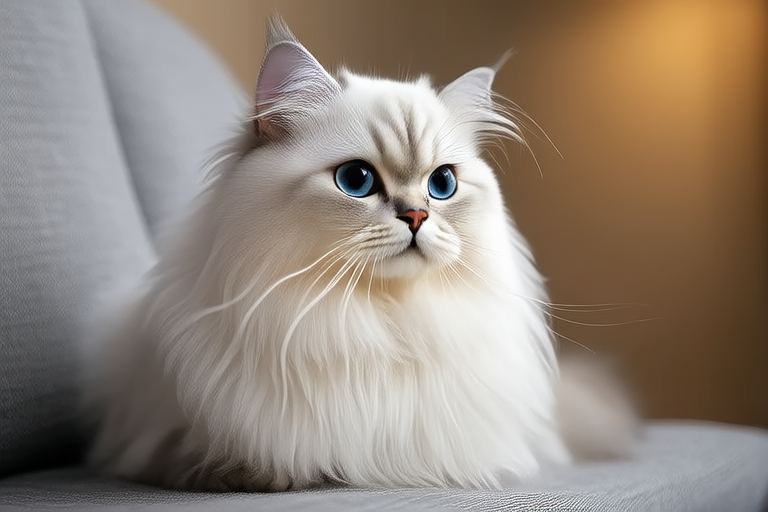
Unveiling the Luxurious Life of Persian Cats: Facts You Need to Know
The Persian cat, with its regal appearance and aristocratic bearing, has been captivating hearts for centuries. This ancient breed, believed to have originated in Persia (modern-day Iran), is one of the oldest domesticated cat breeds. The Persian cat’s distinct appearance, combined with its gentle and affectionate nature, makes it a popular choice among cat enthusiasts worldwide.
A Brief History and Distinctive Appearance
Persian cats have a long and storied history, with their origins traced back to the courts of ancient Persia. They were introduced to Europe in the 17th century and have since become a favorite among royalty and nobility. The breed’s striking appearance includes a round face, large, expressive eyes, and a plush, flowing coat. Their luxurious fur, which can come in a variety of colors and patterns, is one of their most recognizable features. The Persian cat’s coat requires regular grooming, adding to the breed’s regal image.
Luxurious Lifestyle: Grooming Needs
The Persian cat’s luxurious lifestyle begins with its grooming routine. Their thick, long coats demand daily brushing to prevent matting and tangling. Owners must be prepared for the time and effort required to maintain this majestic appearance. Regular baths are also necessary to keep the coat clean and free from dirt and debris. Special care should be taken during shedding seasons to manage loose hair effectively. This meticulous grooming not only keeps the cat looking its best but also helps maintain the overall health of the coat.
Dietary Preferences
Persian cats have specific dietary needs that support their luxurious lifestyle. A high-quality diet rich in protein, vitamins, and minerals is essential for maintaining their coat and overall health. Owners should consult with veterinarians to determine the best diet for their Persian cat, considering factors such as age, activity level, and any existing health conditions. Fresh water should always be available to ensure proper hydration.
Living Environments
To live up to their regal status, Persian cats thrive in environments that cater to their comfort and well-being. A calm and quiet home environment is ideal, as these cats prefer a peaceful setting over chaotic or noisy surroundings. Persian cats enjoy lounging on soft, comfortable furniture, so providing them with cozy resting spots is essential. Additionally, Persian cats appreciate vertical spaces, such as cat trees or shelves, where they can observe their surroundings from a height.
Temperament and Interaction with Humans
Persian cats are known for their gentle and affectionate nature, making them excellent companions for families and individuals alike. They are generally calm and docile, often described as being “lap cats” due to their preference for close contact with their human companions. Persian cats enjoy being petted and stroked, and they tend to form strong bonds with their owners. However, they are not overly demanding and can be content with moderate attention and interaction.
Health Concerns Specific to the Breed
Despite their regal appearance, Persian cats are prone to certain health issues that potential owners should be aware of. Respiratory problems, including upper respiratory infections and chronic bronchitis, are common due to their flattened faces. Polycystic kidney disease (PKD) is another significant concern, affecting many Persian cats. Regular veterinary check-ups and genetic testing can help monitor and manage these conditions. Early intervention and proper care can significantly improve the quality of life for affected cats.
Common Misconceptions
One common misconception about Persian cats is that they are aloof and independent. In reality, they are quite the opposite, seeking out human companionship and affection. Another myth is that all Persian cats are prone to obesity. While it’s true that they require careful monitoring of their diet and exercise, a balanced lifestyle can help prevent weight-related issues. Lastly, some people believe that Persian cats are difficult to train. However, with patience and positive reinforcement, Persian cats can learn basic commands and tricks.
Tips for Ensuring a Healthy and Happy Life
To ensure that your Persian cat leads a healthy and happy life, consider the following tips:
- Grooming Routine: Establish a consistent grooming schedule to keep your Persian cat’s coat in top condition. Regular brushing, bathing, and nail trimming are essential.
- Diet and Hydration: Provide a balanced diet tailored to your Persian cat’s specific needs. Ensure fresh water is always available to promote proper hydration.
- Veterinary Care: Schedule regular check-ups with a veterinarian to monitor your cat’s health and address any concerns promptly.
- Mental Stimulation: Engage your Persian cat with interactive toys and puzzles to keep them mentally stimulated and entertained.
- Safe Environment: Create a safe and secure living environment that minimizes stress and provides comfort. Persian cats thrive in calm and quiet settings.
- Social Interaction: Spend quality time with your Persian cat, offering affection and attention to strengthen your bond.
In conclusion, the Persian cat is a breed that exudes elegance and grace, with a luxurious lifestyle that demands attention to detail. By understanding their grooming needs, dietary preferences, and health concerns, you can provide the care and environment necessary for your Persian cat to thrive. With proper care and love, your Persian cat will lead a healthy and happy life, becoming a cherished member of your family.






